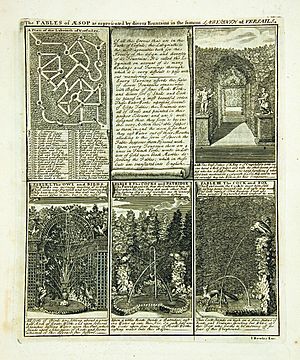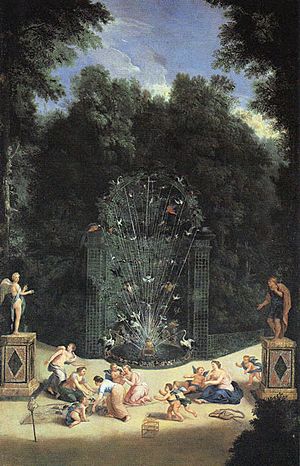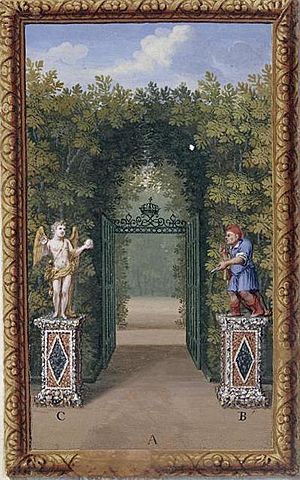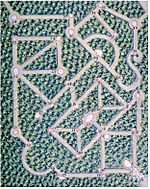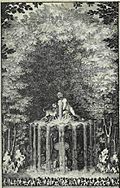The labyrinth of Versailles facts for kids
The Labyrinth of Versailles was a special hedge maze in the amazing Gardens of Versailles in France. It was filled with cool fountains and sculptures that showed stories from Aesop's famous fables.
The maze was first planned in 1665 by André Le Nôtre. But in 1669, Charles Perrault, who wrote the Mother Goose stories, suggested to King Louis XIV that they add thirty-nine fountains. Each fountain would tell a different Aesop's fable.
Workers built the labyrinth between 1672 and 1677. The fountains had water jets that shot out of the animals' mouths, making it look like they were talking! Next to each fountain, there was a plaque with a short poem by Isaac de Benserade that explained the fable. A detailed book about the labyrinth, called Labyrinte de Versailles, was even published with drawings by Sébastien Leclerc.
Sadly, in 1778, King Louis XVI had the labyrinth taken down. He replaced it with a garden of exotic trees, designed in an English style.
Contents
Building the Maze
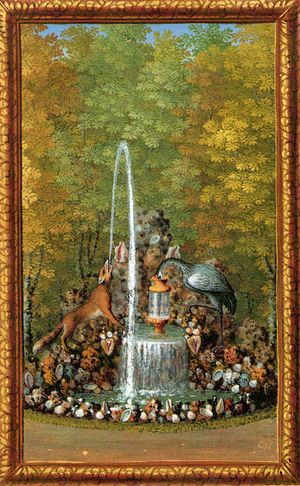
In 1665, André Le Nôtre first designed a simple hedge maze in the gardens. It was located south of the Latona Fountain.
Around that time, Jean de La Fontaine published his first collection of fables. These stories were very popular. This might have encouraged Charles Perrault to suggest a new idea to King Louis XIV in 1669. Perrault thought the maze could be a fun way to help the King's young son, Louis, le Grand Dauphin, learn.
So, between 1672 and 1677, Le Nôtre redesigned the labyrinth. It now featured thirty-nine fountains that showed scenes from Aesop’s Fables. Talented sculptors like Jean-Baptiste Tuby and Etienne Le Hongre created these amazing water sculptures.
Each fountain had a plaque with the fable printed on it. The poet Isaac de Benserade wrote short poems for each one. It's said that King Louis XIV's son learned to read using these plaques! De Benserade even claimed the King himself chose the fables and wanted the poems.
When it was finished in 1677, the labyrinth had thirty-nine fountains and 333 painted metal animal sculptures. All the water for these fountains came from the Seine River. It was brought using a huge machine called the Machine de Marly, which had many water-wheels and pumps.
The maze itself was quite unique. It didn't have a single goal in the middle. Even though the hedges were about 5 meters (16 feet) tall, you could still catch glimpses of what was ahead. Jean-Aymar Piganiol de La Force described it in 1702 as a "network of paths bordered with hedges where it is easy to get lost." He also mentioned that "At every turn you see a fountain decorated with delicate rocaille, and representing very simply a fable."
Soon after the labyrinth was finished, Perrault wrote about it. He said that at every turn, you could see three, four, or even six or seven fountains at once. He described the animal sculptures as "so well made and lifelike that they seem to be still in the action that they depict." He added that the water spouting from them "seems not only to give them life and action, but serves them also as a voice."
Why It Was So Popular
The labyrinth was a huge hit! Not just with the King and his son, but also with the nobles and important visitors who came to the gardens. It was so popular that a special guidebook was published. This book, Perrault's Labyrinte de Versailles, included the fables, descriptions of the fountains, and the poems by Isaac Benserade.
It was first published in 1675 and then reprinted in 1677 with cool drawings by Sébastien Leclerc. A third version even had the drawings colored by Jacques Bailly. These small, pocket-sized books were often beautifully bound in red leather with gold designs. The book was later translated into English, appearing in 1768.
The labyrinth made the Gardens of Versailles even more amazing for visitors and diplomats from other countries. An illustrated guide from 1682 praised the labyrinth, saying it was "nothing more admirable and praiseworthy." It noted that even though the maze had many turns, it wasn't boring because of the figures and water-works showing Aesop's fables.
The composer Marin Marais, who worked for the royal court in 1676, knew the labyrinth well. He even wrote a piece of music called The Labyrinth and other stories. In it, he describes entering the labyrinth and finding his way through different musical "keys" and "dissonances," just like someone lost in a maze. He then happily finds his way out with a graceful dance tune.
Aesop, Love, and Wisdom
At the entrance to the labyrinth, there were two statues. One was of Aesop (B) holding a scroll, made by Le Gros. The other was of Love, or Cupid (C), holding a ball of thread, like Ariadne's thread.
Perrault explained what these two figures meant. He wrote that Aesop shows his scroll to Love, who has a ball of thread. This was like saying that even if life puts people in tricky situations, there's a way out if Love is guided by wisdom. Aesop's fables, of course, teach wisdom.
Some people, like Michel Conan, believed the maze encouraged visitors to think about their choices. The statues suggested that if you didn't think carefully, you might get lost. For them, the labyrinth was like a metaphor for life. It encouraged you to think about yourself and find your own rules for living. The conversation between Cupid and Aesop at the entrance highlighted this idea:
Cupid:
Yes, I can now close my eyes and laugh: with this thread I'll find my way.
Aesop:
Love, that slender thread might get you lost: the slightest shock could break it.
The Fables in the Labyrinth
Here are some of the fables that were shown in the labyrinth's fountains:
- Owl and Birds
- Cocks and Partridge
- The Cock, the Dog and the Fox
- The Cock and the Jewel
- The Cat and the Mice
- The Eagle and the Fox
- The Jay and the Peacock
- The Cock and the Turkey-cock
- The Peacock and the Jackdaw
- The Viper and the File
- The Ape's Twin Offspring
- The Bat
- Hen, Chicks and Kite
- The Fox and the Stork, first part
- The Fox and the Stork, second part
- The Peacock complains to Juno about his Voice
- The Parrot and the Ape
- The Wolf and the Fox before Judge Ape
- The Frog and the Mouse
- The Tortoise and the Hare
- The Wolf and the Heron
- The Kite and the Birds
- The Ape and the Fox
- The Fox and the Goat in the Well
- The Mice in Council
- The Frogs ask Zeus for a King
- The Monkey and the Cat
- The Fox and the Grapes out of Reach
- Eagle and Beetle
- The Wolf and the Porcupine
- The Snake with several Heads
- The Mouse, the Cat and the little Cock
- The Kite and the Doves
- The Ape and the Dolphin
- Fox and Crow
- The Swan and his Owner
- The Fox and the Mask
- The Snake and the Porcupine
- The Ducks and the Water-Spaniel
The End of the Labyrinth
King Louis XVI ordered the labyrinth to be destroyed in 1778. He said it was too expensive to fix and keep up. In its place, a new garden was planted with different kinds of trees, designed in an English style. This area was renamed Bosquet de la Reine, which means "Queen's Grove."
Today, only thirty-four small pieces of the fountains remain. These are kept in the museum collections at Versailles. The statues of L'Amour (Love) and Aesop also still exist.
Images for kids
- Links to almost all of the fables on shanaweb.net page on Perrault (in French)


